As we end the first week of April 2023, teams continue their treks to Everest Base Camp (EBC). Meanwhile, bad weather has brought climbing to a halt on Annapurna. Reports of heavy snow may make the 2023 spring season more challenging than we’ve seen in years. But the good news is the fixed ropes are set from EBC to Camp 2, and the Icefall is officially open.
Last Week
Politics
Nepal government politics continue to confuse trekkers and, in some cases, delay supplies reaching EBC. First, it was mixed messages on solo trekkers. Certain authorities, such as in the Khumbu, which includes Everest, said they would ignore a directive from the Tourism Board that all trekkers must hire a porter or a guide. Then the Board issued a stronger statement that the rule would go into effect on April 1, 2023, and violators would be fined. At this point, reports are coming in that no one is checking for TIMS cards, which are used for identification and guides, and no fines have been levied. We’ll see how this sorts out.
The second snafu came from authorities out of the Syangboche Municipality, which said helicopters were banned from flying to EBC. This was huge because almost every commercial expedition flies tons of gear, from tents, tables, fuel, stoves, food and other heavy items that cannot be carried by yaks or porters. I checked with Pemba Sherpa of 8 K Expeditions, and he said they had resolved the dispute. While reducing helicopter traffic would be good for many reasons, this felt arbitrary and last minute.
Shortened climbs
Teams are slowly arriving at EBC, but most are still on the trek. And many teams have not even arrived in Kathmandu. Commercial expeditions are starting later and later each year primarily due to two factors:
Acclimatizing at Home: The use of hypoxia tents has dramatically increased for 8000-meter climbers. By using a generator, some oxygen is removed from the ambient air and pumped into a plastic tent that covers a person’s head or entire body while they sleep at home. This causes the body to react similarly to being at a high altitude, thus creating additional critical red blood cells to carry oxygen to the muscles on the climb. Depending on the generator and protocol, climbers can arrive in Nepal acclimatized high as 7,000 meters or the equivalent of Camp 3.
Please listen to my recent Podcast with Lukas Furtenbach of Furtenbach Adventures and Everest Oxygen on his approach. His teams will not arrive in Nepal until late April and then make one climb on Mera Peak before making only one climb on Everest – from EBC to the Summit and back. In other words, only one round trip through the Icefall. His “Flash” expeditions take three weeks, home to home.
Higher Oxygen Flow Rates: The use of supplemental oxygen on the mountain has also dramatically changed. Today, it is common for an Everest climber to go on O’s at Camp 2, or 6500 meters, instead of the more traditional Camp 3 at 7000 meters. Also, the flow rates have increased from two liters per minute to four, six or even eight lpm for brief highly-physical sections, i.e., the Hillary Slope. This high flow rate allows climbers to go faster and potentially eliminate at least one rotation to the high camps.
Large Teams
As of April 7, the Ministry of Tourism has issued 178 permits for Everest and 60 for Lhotse. I expect around 400 for Everest.
Consistent with previous years, many of the dominant Nepali/Sherpa-owned guide companies have stunningly large teams. Seven Summtis treks reports for 70+ Everest and 25 for Lhotse. They are running expeditions on seven of Nepal’s 8000ers with a Sherpa support staff of over 500. In 2023, look for the client-to-Sherpa support ratio to be around 1: 1.8
Meanwhile, the long-time established foreign operators have their traditional sizes. For example, Adventure Consultants has around ten climbers, Alpine Ascents has five, Mountain Professionals with twelve, and Summit Climb at eight. A few foreign operators have large teams of between fifteen to thirty clients. These include IMG, Climbing the Seven Summits (CTSS), and Madison Mountaineering.
Next Week
Look for EBC to begin to fill with teams. A few will make their first rotation to Camp 1, thus beginning the acclimatization process. And Sherpas will probably begin fixing the Lhotse Face. You read the term “fixing the route” and “fixed ropes” all the time, so let’s take a moment to explore what these terms mean.
“Fixing” the Mountain
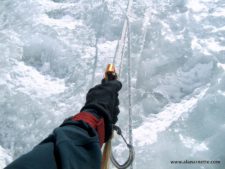
Simply put, a thin nylon rope, aka “fixed line,” is anchored to the mountain side marking the path, aka “route” climbers should take. The rope is about the thickness of your thumb and is attached to the climber’s harness using a carabiner and a jumar. To see how the rigging is set up, Tim Mosedale has a nice description on his site. While it may seem silly that mountain climbers need a rope to mark the trial, there’s more to it than marking the path.
Who Does the Work?
In general, the route is set by dedicated teams of Sherpas on the Nepal side and Tibetans on the Tibet side.
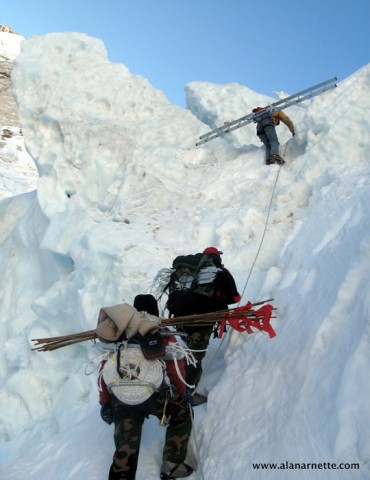
On the south side, the Icefall Doctors, a team of eight dedicated Sherpas, install, aka “fix,” the route from Everest Base Camp to Camp 2 in the Western Cwm each year. They first scout the route for the safest and most direct path and then carry on their backs hundreds of pounds of rope, ladders, ice screws and pickets into the Icefall and the Western Cwm to create the route.
The ropes must be reset each season because the ultraviolet rays from the sun will rot the ropes causing them to fail under the weight of a climber’s fall. In addition, the route must be maintained daily through the season, given that the Icefall is a moving glacier and can move up to three feet a day. This movement will cause ladders to drop into crevasses, bend them or move them into a dangerous area. The Doctors inspect the route at least once a day throughout the season to keep it open and safe.
From Camp 2 to the summit on the south side, Sherpas from one commercial team set the route. Again, they carry ropes and anchors on their backs and work together to fix the “fixed rope,” aka safety lines to the mountainside. In 2017, a major change occurred when the Nepal government allowed the ropes and anchors to be helicoptered to Camp 2, thus saving an estimated 78 Sherpa loads thru the Icefall. This was a pure safety decision.
On the Tibet side, a dedicated team of Tibetan climbers performs the same duties, but they set the route from Advanced Base Camp to the summit, and the commercial teams do not participate in the effort. The ladder at the 2nd Step, installed in 1975, is attached permanently but has been replaced a couple of times.
On both sides, the labor and material are funded thru climbing permits or collections from the teams.
Why Fixed Ropes?
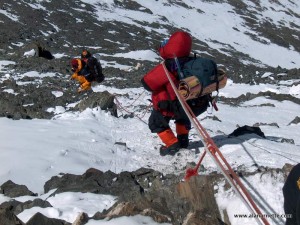
In addition to marking the route, which is extremely useful in whiteout conditions, the fixed line also provides a safety net for a climber in the event of a fall. If the 1996 climbers had been able to follow the fixed rope to the South Col, many would have lived.
The problem that has been occurring in recent years is that the line can only support so much weight, and it is common to have 30, 50 or even 100 people attached to the same rope. While, amazingly, it has never happened, if the climbers were to fall together, the lines would fail under the load. So in many high-traffic areas, there are dual lines established, one for climbers ascending and one for descending climbers. In 2023, this dual-route is established on the Lhotse Face.
There are two routes on the Hillary Step, now a slope after the 2015 earthquake changed the topology. But sometimes, there is simply not enough room for dual ropes. Also, remember that it takes human effort to haul the gear high on the slopes and attach it to the mountain.
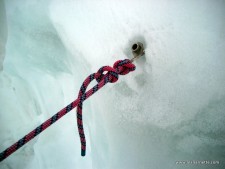
The ropes are attached to the mountain by using ice screws, primarily in the Icefall or very icy areas, but more often by driving an aluminum picket into the snowy mountainside and attaching the rope using another segment of rope. All in all, this is very time-consuming, and it takes days to get the route set to the summit. That is why we rarely see summits in April, as the Tibetans and Sherpas are busy establishing the route while the climbers are acclimatizing.
Is this really necessary? Certainly, Everest has been climbed successfully without the use of fixed ropes, but exceptionally skilled and experienced Alpinists have done this like Reinhold Messner. In 2007, Conrad Anker climbed the 2nd Step on the North side without using the ladder as a test the see if it could be done.
Without the fixed ropes, the death toll would be significantly higher. Fixed ropes are used on most 8000-meter mountains, including K2. On lower peaks, including Denali, Rainier or Mont Blanc, it is common for climbers to climb roped together but not on a fixed-line. If one person falls, the others are responsible for stopping that fall.
Ropes are a key part of climbing, alpine, siege style, or rock. After a few weeks on the mountain, that rope becomes your best friend, and in case of a fall, it is a genuine lifesaver.
Climb On!
Alan
Memories are Everything
The Podcast on alanarnette.com
You can hear #everest2022 podcasts on Spotify, Apple Podcast, Google Podcasts, Pocket Casts, RadioPublic, Anchor, and more. Just search for “alan arnette” on your favorite podcast platform.
Why this coverage?
I like to use these weekend updates to remind my readers that I’m just one person who loves climbing. With 37 serious climbing expeditions, including four Everest trips under my belt and a summit in 2011, I use my site to share those experiences, demystify Everest each year and bring awareness to Alzheimer’s Disease. My mom, Ida Arnette, died from this disease in 2009, as have four of my aunts. It was a heartbreaking experience that I never want anyone to go through; thus, my ask for donations to non-profits where 100% goes to them, and nothing ever to me.
![]()

Summit Coach
If you dream of climbing mountains but are not sure how to start or reach your next level, from a Colorado 14er to Rainier, Everest, or even K2, we can help. Summit Coach is a consulting service that helps aspiring climbers throughout the world achieve their goals through a personalized set of consulting services based on Alan Arnette’s 25 years of high-altitude mountain experience, including summits of Everest, K2, and Manaslu, and 30 years as a business executive.

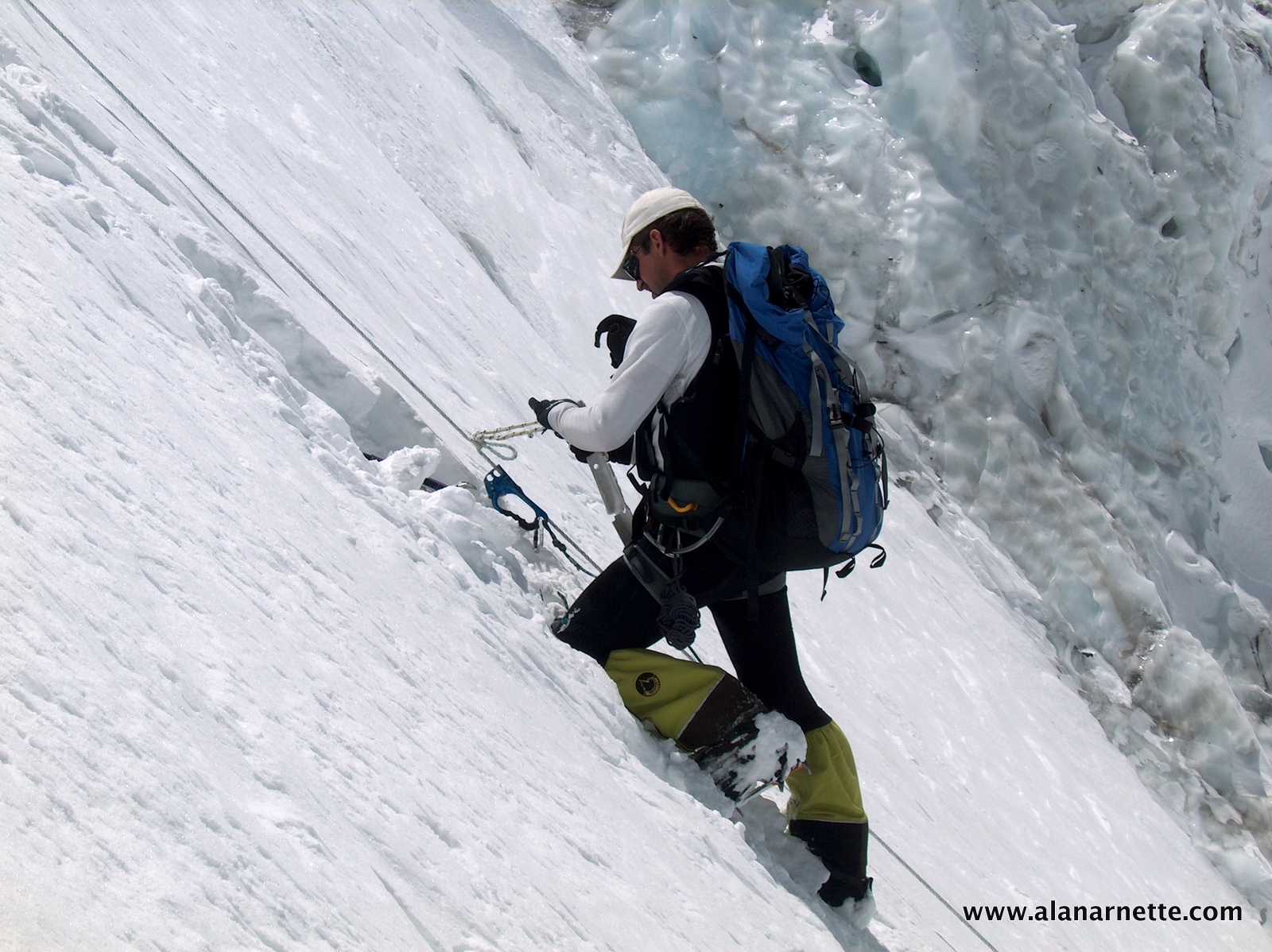
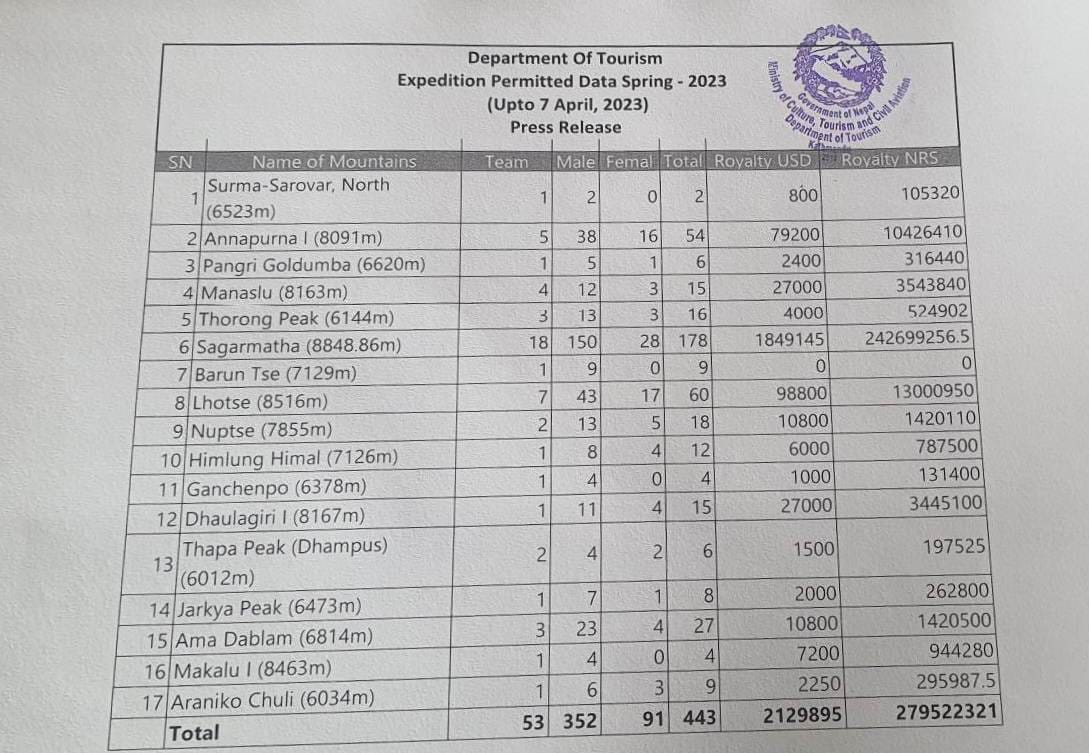





2 thoughts on “Everest 2023: Weekend Update April 8”
I have summited all the volcanos in nw but at 69 my big mtns are done happy trails
Regarding hypoxia tents, I’m a beginner and I’ll be taking on Island Peak this week. I’ve used Intermittent Hypoxic Training for the last month in order to give myself the best chance of sumitting. I have a problem with my red blood cells not picking up as much oxygen as normal people, so I’m hoping this will help. If you like, I’ll let you know how I get on. Climb on! Andy
Comments are closed.